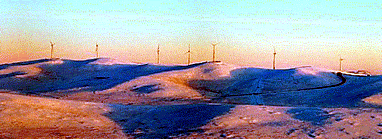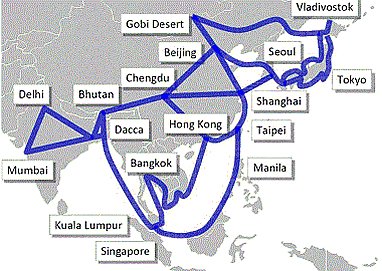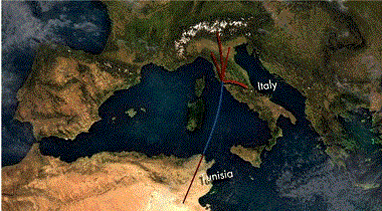 Powering up Asia's super-gridDec 01, 2012 - John A Mathews - atimes.com The integration of East Asia is a topic of perennial interest - whether it be monetary integration (much discussed in the wake of the 1997 financial crisis), trade integration (promoted via ever-expanding FTA areas) or even political integration. But what is not widely discussed (as yet) is actually the best hope for effective integration - and that is energy integration, via an Asian super grid linking the enhanced electric power systems of China, Japan, Korea, Mongolia and perhaps Russia. Just such an Asian super grid has been proposed - by the charismatic Softbank CEO Son Masayoshi, driver of Japan's post-Fukushima shift to a renewable energy pathway. The first steps towards the Asian super grid (ASG) were taken in October, when SB Renewables, Son's new subsidiary specializing in renewable energy, announced an agreement with a company in Mongolia, Newcom, to develop a site in the Gobi desert for a giant wind farm that would feed renewable power into the grid. [1] It is anticipated that by the end of 2012 SB Renewables and Newcom will have identified the site for the first wind farm in the Gobi desert through a joint venture, Clean Energy Asia, established in March this year. The proposed wind farm would be rated at 300 megawatts (the equivalent of a thermal power plant), and could be operational as early as 2014. Feasibility studies for three other sites have already been commissioned, with power capacity of 7 gigawatts - or the equivalent of seven nuclear power stations. Newcom has already established a track record, building Mongolia's first wind farm in record time, and set to bring it to fruition by the end of 2012. Mongolia is a classic instance of a latecomer country powering ahead through heavy utilization of its vast fossil fuel reserves (mainly coal). It is a country sharing major borders with China and Russia that has had unprecedented flows of inward foreign investment from companies like Rio Tinto to build its coal export industry - much of that coal going to power China's black industrial revolution. But at the same time, Mongolia is seeing the development of vast wind farms that promise a genuine green revolution. Newcom, led by its English-speaking CEO, Bayanjargal Byambasaikhan, is creating a huge new wind farm at Salkhit, just outside the capital Ulaanbaator, where 31 wind turbines are being brought into commission to generate 5% of the country's power needs (now totally dependent on coal). [2]
Salkhit Wind Farm This is only the start. Newcom and Byambasaikan see a future where Mongolia's wind resources can be harnessed to power not only its own development but also much of China's and Asia's electric grids, earning profits for Newcom and export earnings for Mongolia. Japan Renewable Energy Foundation The breathtaking scope of the ASG proposal is of a piece with the other far-reaching initiatives taken by Son's SB Renewables and JREF - including a series of solar farms in Japan designed to take advantage of the new feed-in tariffs launched in Japan on July 1st 2012. Indeed JREF and SB Renewables have been driving the debate over the phase-out of nuclear and accelerated uptake of renewables. (See Andrew DeWit's articles such as "Japan's new green political innovators respond to government attempts to restart nuclear power", June 13, 2012, and DeWit, "Japan's remarkable Renewable Energy drive - after Fukushima", March 11, 2012.) Dr Kaberger outlined the ASG proposal in further detail at a presentation in Mongolia in March - see Figure 1. Figure 1: Asia super grid proposal from Japan Renewable Energy Foundation
Source: Japan Renewable Energy Foundation The core idea is that wind farms (and possibly solar farms as well) in the Gobi desert can be linked via high-tension transmission lines to Korea, Japan and possibly Russia; to China; and thence (more speculatively) to Taiwan, Thailand, the Philippines, and even India. The costs of generating power in the desert locations would be low, and provided the transmission costs can be kept low enough through utilization of high-capacity HVDC lines (which China for example is installing under its plans for grid upgrading under the 12th Five-Year Plan), the power delivered in the various countries would be competitive with thermal or nuclear power. Figure 2: The Desertec proposal
Source: Desertec Foundation The same idea underpins the proposal from the Desertec Foundation to link European grids with solar power stations in the deserts of North Africa (Figure 2). The Desertec proposal has been championed by German firms (despite some recent high-profile withdrawals), and other firms in Europe - most of whom would envisage being involved in the building of any eventual interconnected grid utilizing renewable power. The proposal has received a significant boost since the Arab Spring uprisings, offering North African countries like Tunisia, Libya and Egypt new possibilities of generating energy to power their industrialization and to have a product to export as well. Indeed there is already an initiative linking Tunisia with Italy, promoted by a consortium consisting of Nur Energie (a British firm with a French name) and Top Oilfield Services, an oil and gas engineering firm operating from Tunisia (the TuNur consortium). The Tunisian solar park would be rated at 2 GW, or equivalent to two nuclear power stations. The proposal calls for an undersea high-tension cable linking the Tunisian solar park with the Italian grid, as shown in Figure 3. [3] In short, the idea of the Asian super grid in itself is not so far-fetched - and when I discussed the proposal with Son at the Global Green Growth summit in Seoul in May this year (where we were both speakers), he was confident that the proposal is sound and can be implemented. He outlined to me the basic concept that drives it - free trade in electric power. Figure 3: TuNur proposal for a first electric power linkage between Italy and Tunisia
Source: Desertec Foundation Basic concept of the ASG As in Son's earlier ventures into IT, computing and telecommunications, his strategy is to tackle established monopolies and take advantage of liberalization to create effective competitors that sow the seeds of creative destruction. In the case of the ASG, the established firms are the large electric power firms (like Tepco in Japan or Chinese giants like China Datang and China Southern Power Grid Co), and the concept depends on being able to break their quasi-monopoly control over electricity markets by trading electricity as a commodity between the established (and enhanced) national grids. Trading electricity! Indeed, what's wrong with the idea? When Son Masayoshi and I met in Seoul in April, he told me that he had asked officials at Japan's Ministry of Economy, Trade and Industry (METI) whether it was "illegal" to import electric power, in competition with the established monopolistic power generators such as Tepco. He said the officials were nonplussed. They told him that it wasn't legal, in the sense that there were regulations covering it - but neither was it illegal. His intervention has evidently sparked a scramble at METI to deal with the prospect of a super-competitive electric power market able to import renewable power from sites such as Mongolian wind farms. This is meat and drink to Son, who sparked such scrambles in his earlier interventions via Softbank into the information technology, personal computer and telecommunications markets in Japan. There is one immediate obstacle. Japan's Electricity Business Act has an article restricting foreign companies from supplying electricity in Japan - so that represents a legislative hurdle that would need to be cleared if the ASG is to become a reality. Assuming Son gets the go-ahead to import electric power, he foresees a relatively simple initial step as involving a link between Japan's southern island of Kyushu and South Korea - calling for a 400 kilometer high-tension cable embodying the latest 700 kV HVDC technology. This cable length is comparable to the existing link in Europe between Norway and the Netherlands (two of the rare countries that have actually interconnected their power grids), which is 580 km long and was completed in 2008 (14 years after the two countries agreed in principle to link their grids). Obviously Son intends to move at a faster pace than that. The way would then be open to build the infrastructure that would carry current at very high amperage levels from renewables hotspots such as the Gobi desert to industrial centers in China, Korea and Japan. But just as important as the infrastructure would be the political agreement to allow free trade in electric power between these grids. This might be a (relatively) small step for the countries concerned, but it would be a giant leap for mankind. For it would bring a resolution to the logjam that has been holding back renewable energy, keeping it as a marginal player in individual countries with their powerful fossil fuel vested interests. Free trade in electric power would break that logjam very effectively - just as Son's business models have broken incumbent oligarchies in IT, PCs and telecoms in Japan. The Asian super grid would then open the way to similar grand proposals, linking North Africa and Europe, and the southwest of the US to the eastern seaboard. The reason that this is such an important initiative is that the empowered grid, rendered "smart" with IT to moderate intermittent power supplies with fluctuating demand and "strong" through the deployment of new HVDC cables to carry renewable power long distances, is the backbone of any substantial push towards a renewable energy future. Over and above what can be done with individual renewable energy technologies and sources, the grid itself has to be enhanced and rendered competitive, so that a multitude of small power generators can be enabled to supply power to the grid, which would be able to accommodate them. Feed-in tariffs complement such a strategy perfectly - which is why they have been so effective in Germany and should now prove their worth in Japan (since the new feed-in tariffs were introduced on July 1) and in China (where provincial-level feed-in tariff experiments were introduced in 2012). Indeed the free-market approach being championed by Son Masayoshi in Japan complements the approach to market expansion favored by feed-in tariffs, in that both envisage market expansion as stemming from the cumulative and aggregate effect of thousands and eventually millions of decentralized decisions over what to connect to the grid and how to do so. China's huge investments in the smart grid are needed to accommodate such decentralized power generation - while its promotion of vast quasi-monopolies in power generation (such as the State Grid Corporation of China) will eventually work against such a process. For now, State Grid Corp plays a positive role in upgrading China's grid and equipping it to accommodate varying renewable inputs - including those from new sources such as wind farms in Mongolia. Cost advantages will drive the ASG Now Son Masayoshi reckons that costs to generate
wind power in the Gobi desert would be far below
these levels, at around 3 to 4 yen per kWh, assuming
that land for the wind farms could be leased virtually
rent-free. The transmission costs from Mongolia to
Japan he reckons at around 2 yen per kWh, making
the total of 5 to 6 yen per kWh - much less than
current Japanese power costs. Towards free trade in clean-tech goods, services Since then, the ITA has ensured that trade in IT products has been largely free of trade barriers and has boosted the uptake of IT products and services in developing countries, accelerating the development of China, India and other emerging giants. The ITA is so far the only such agreement of its kind endorsed by the WTO. [6] The idea has received enthusiastic endorsement from no less an entrepreneur than Shi Zhengrong, founder of Suntech, the world's largest solar panel producer. The case for a similar Clean Tech Agreement to counter the protectionist tendencies evident in the imposition of tariffs against solar modules by the US (and threatened action from the EU) is powerful. (See here my European Energy Review article on the US and EU trade sanctions on solar PV panels from China, and their likely boomerang effects.) But in the current trade environment, with hostilities in the air, it is unlikely that a push for a WTO-endorsed CTA would be successful. This is where the Asian super grid and its foundation in free trade in clean electric power comes in. If Son and JREF are successful in promoting the idea (and the initial agreement with Newcom to develop huge wind farms in the Gobi is a strong pointer to its viability), then free trade in the fundamental clean technology - green electric power - would be established for the East Asian region. If free trade in green electric power proves its worth in promoting the transition to a clean energy and economic future (as well as boosting the clean development of countries like Mongolia), then it is a short step to realizing the benefits of free trade in clean-tech goods and services generally - thus giving advanced countries like Japan and South Korea a vast market for their clean-tech goods and services, and promoting China's clean-tech development over its black, fossil-fueled rival. Such an agreement would establish the Inner Asian-East Asian clean-tech region as world leader in the emerging clean technologies of the 21st century - so that the EU, the US and other emerging regions will also wish to join or emulate it. Thereby lies the path to a global CTA that could be presented to and endorsed by the WTO - helping to prevent the trade spats that already threaten to derail the clean-tech revolution. Indeed the countries of the Asia-Pacific Economic Cooperation forum have already taken the first steps towards such a comprehensive CTA, in their historic step of committing to reduce all tariffs on "environmental goods" to a maximum of 5% by 2015. This step, announced at the Leaders' Summit in Vladivostok in September, creates an expanded market for goods such as solar cells and wind turbines, and thereby expands the market for exports from Japan, the US and Australia, as well as China and Korea, thereby reducing costs of importing clean-tech products for the rapidly developing countries of Southeast Asia. [7] The final point worth noting is that many of the sources of tension within and linked to East Asia - such as disputes over territorial claims to the sea around remote islands involving China, Japan, Korea and Southeast Asia - involve access to fossil fuels. These are international disputes that stem from the "business as usual" model of industrialization and its assumption that access to fossil fuels is the critical factor in successful transition to modernity. But the clean-tech paradigm represents a sharp break with this thinking - and with it, reduces the potential for such disputes. There is therefore much at stake in the success of the free trade approach to clean technology being championed by business leaders such as Son Masayoshi from Japan and Shi Zhengrong of China. Notes: John A Mathews is Professor of Management, Macquarie University, Australia, and Eni Chair of Competitive Dynamics and Global Strategy at LUISS Guido Carli University in Rome
|



